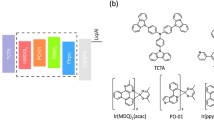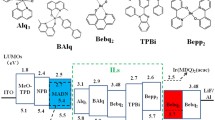Abstract
Two kinds of highly efficient, bright hybrid white organic light emitting diodes have been fabricated by utilizing ambipolar material 4,4-N,N-dicarbazolebiphenyl (CBP) and unipolar material N,N′-di(naphthalene-1-yl)-N,N′-diphenyl-benzidine (NPB) as the spacer, respectively. By adjusting the thickness of spacers together with effectively utilizing combinations of exciton-harnessed orange-phosphorescence/blue-fluorescence, the current efficiency of optimal device with CBP spacer and device with NPB spacer are 31.0 and 38.9 cd/A, the maximum power efficiency are 23.9 and 29.1 lm/W, the maximum brightness are 87,249 and 75,501 cd/m2, and the Commission Internationale de l’Eclairage (CIE) coordinates are (0.42, 0.43) and (0.47, 0.44) at a voltage of 11 V, respectively. Furthermore, systematic investigations focused on the effects of spacers on device performance have been performed. By virtue of the multifunctional spacer, energy transfer between the phosphorescent and fluorescent emitters can be avoided while the carriers still can pass through this spacer bridge, which is important to realize such high device performance. In addition, a novel concept that both ambipolar materials and unipolar materials can be the promising candidates for spacers has been proposed if the thickness of spacers with high triplet energy is optimized.








Similar content being viewed by others

References
Zhang W, Wu Z, Zhang X et al (2011) Dependence of the stability of organic light-emitting diodes on driving mode. Chin Sci Bull 56:2210–2214
Peng J, Xu Y, Hou Q et al (2002) Electroluminescence and photoluminescence of dioctylfluorene and 4,7-dithien-2-yl-2,1,3-benzothiadiazole copolymers. Chin Sci Bull 47:1714–1717
Sasabe H, Kido J (2013) Development of high performance OLEDs for general lighting. J Mater Chem C 1:1699
Zou J, Wu H, Lam C et al (2011) Simultaneous optimization of charge-carrier balance and luminous efficacy in highly efficient white polymer light-emitting devices. Adv Mater 23:2976–2980
Liu B, Xu M, Tao H et al (2013) Highly efficient red phosphorescent organic light-emitting diodes based on solution processed emissive layer. J Lumin 142:35–39
Luo D, Lan L, Xu M et al (2012) High reliability amorphous oxide semiconductor thin-film transistors gated by buried thick aluminum. Phys Status Solidi RRL 6:403–405
Lecamp G (2013) Light outcoupling for OLED: double the efficiency while keeping the dark current low. SID Digest 43:597–599
Reineke S, Lindner F, Schwartz G et al (2009) White organic light-emitting diodes with fluorescent tube efficiency. Nature 459:234–239
Duan Y, Mazzeo M, Maiorano V et al (2008) Extremely low voltage and high bright p-i-n fluorescent white organic lightemitting diodes. Appl Phys Lett 92:113304
Jou JH, Wu MH, Wang CP et al (2007) Efficient fluorescent white organic light-emitting diodes using co-host/emitter dual-role possessed di(triphenyl-amine)-1,4-divinyl-naphthalene. Org Electron 8:735–742
Sun Y, Giebink N, Kanno H et al (2006) Management of singlet and triplet excitons for efficient white organic light-emitting devices. Nature 440:908–912
Giebink NC, Sun Y, Forrest SR (2006) Transient analysis of triplet exciton dynamics in amorphous organic semiconductor thin films. Org Electron 7:375–386
Liu B, Tao H, Su Y et al (2013) Color-stable, reduced efficiency roll-off hybrid white organic light emitting diodes with ultra high brightness. Chin Phys B 22:077303
Zhao F, Zhang Z, Liu Y et al (2012) A hybrid white organic light-emitting diode with stable color and reduced efficiency roll-off by using a bipolar charge carrier switch. Org Electron 13:1049–1055
Ye J, Zheng C, Ou X et al (2012) Management of singlet and triplet excitons in a single emission layer: a simple approach for a high-efficiency fluorescence/phosphorescence hybrid white organic light-emitting device. Adv Mater 24:3410–3414
Chen P, Xie W, Li J et al (2007) White organic light-emitting devices with a bipolar transport layer between blue fluorescent and orange phosphorescent emitting layers. Appl Phys Lett 91:023505
Chen Y, Zhao F, Zhao Y et al (2012) Ultra-simple hybrid white organic light-emitting diodes with high efficiency and CRI trade-off: fabrication and emission-mechanism analysis. Org Electron 13:2807–2815
Zhang LJ, Hua YL, Wu XM et al (2008) White organic light-emitting device with both phosphorescent and fluorescent emissive layers. Chin Phys B 17:3097
Ge G, He J, Guo H et al (2009) Highly efficient phosphorescent iridium (III) diazine complexes for OLEDs: different photophysical property between iridium (III) pyrazine complex and iridium (III) pyrimidine complex. J Organomet Chem 694:3050–3057
Duan L, Zhang D, Wu K et al (2011) Controlling the recombination zone of white organic light-emitting diodes with extremely long lifetimes. Adv Funct Mater 21:3540–3545
Matsusue N, Suzuki Y, Naito H (2005) Charge carrier transport in neat thin films of phosphorescent iridium complexes. Jpn J Appl Phys 44:3691–3694
Shangguan R, Mua G, Qiao X et al (2011) Low sublimation temperature cesium pivalate complex as an efficient electron injection material for organic light-emitting diode devices. Org Electron 12:1957–1962
Baldo MA (1999) Excitonic singlet-triplet ratio in a semiconducting organic thin film. Phys Rev B 66:14422–14428
Jeon WS, Park TJ, Kim SY et al (2009) Ideal host and guest system in phosphorescent OLEDs. Org Electron 10:240–246
Ho MH, Hsu SF, Ma JW et al (2007) White p-i-n organic light-emitting devices with high power efficiency and stable color. Appl Phys Lett 91:113518
Holmes RJ, D’Andrade BW, Forrest SR et al (2003) Efficient, deep-blue organic electrophosphorescence by guest charge trapping. Appl Phys Lett 83:3818
Wang Q, Ding J, Cheng Y et al (2009) Achieving highly efficient white organic light-emitting diodes with reduced efficiency roll-off. J Phys D Appl Phys 42:065106
Seo JH, Park H, Kim GY et al (2008) Hybrid spacer for high-efficiency white organic light-emitting diodes. Appl Phys Lett 92:183303
Schwartz G, Ke TH, Wu CC et al (2008) Balanced ambipolar charge carrier mobility in mixed layers for application in hybrid white organic light-emitting diodes. Appl Phys Lett 93:073304
Acknowledgments
This work was supported by the National Basic Research Program of China (2009CB623604), the National Natural Science Foundation of China (61204087, 51173049, U0634003, 61036007, and 60937001), Fundamental Research Funds for the Central Universities (2011ZB0002, 2011ZM0009), and China Postdoctoral Science Foundation (2013M531841).
Author information
Authors and Affiliations
Corresponding author
About this article
Cite this article
Liu, B., Xu, M., Tao, H. et al. The effect of spacer in hybrid white organic light emitting diodes. Chin. Sci. Bull. 59, 3090–3097 (2014). https://doi.org/10.1007/s11434-014-0469-1
Received:
Accepted:
Published:
Issue Date:
DOI: https://doi.org/10.1007/s11434-014-0469-1



